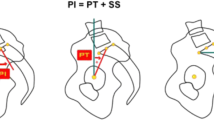Abstract
Introduction
In L5-S1 spondylolisthesis, it has been clearly demonstrated over the past decade that sacro-pelvic morphology is abnormal and that it can be associated to an abnormal sacro-pelvic orientation as well as to a disturbed global sagittal balance of the spine. The purpose of this article is to review the work done within the Spinal Deformity Study Group (SDSG) over the past decade, which has led to a classification incorporating this recent knowledge.
Material and methods
The evidence presented has been derived from the analysis of the SDSG database, a multi-center radiological database of patients with L5-S1 spondylolisthesis, collected from 43 spine surgeons in North America and Europe.
Results
The classification defines 6 types of spondylolisthesis based on features that can be assessed on sagittal radiographs of the spine and pelvis: (1) grade of slip, (2) pelvic incidence, and (3) spino-pelvic alignment. A reliability study has demonstrated substantial intra- and inter-observer reliability similar to other currently used classifications for spinal deformity. Furthermore, health-related quality of life measures were found to be significantly different between the 6 types, thus supporting the value of a classification based on spino-pelvic alignment.
Conclusions
The clinical relevance is that clinicians need to keep in mind when planning treatment that subjects with L5-S1 spondylolisthesis are a heterogeneous group with various adaptations of their posture. In the current controversy on whether high-grade deformities should or should not be reduced, it is suggested that reduction techniques should preferably be used in subjects with evidence of abnormal posture, in order to restore global spino-pelvic balance and improve the biomechanical environment for fusion.





Similar content being viewed by others
References
Mardjetko S, Albert T, Andersson G, Bridwell K, DeWald C, Gaines R, Geck M, Hammerberg K, Herkowitz H, Kwon B, Labelle H, Lubicky J, McAfee P, Ogilvie J, Shufflebarger H, Whitesides T (2005) Spine/SRS Spondylolisthesis Summary Statement. Spine, 30(6 Suppl):S3
Labelle H, Roussouly P, Berthonnaud E et al (2005) The importance of spinopelvic balance in L5-S1 developmental spondylolisthesis: a review of pertinent radiologic measurements. Spine 30(suppl):27–34
Wiltse LL, Newman PH, Macnab I (1976) Classification of spondylolysis and spondylolisthesis. Clin Orthop 117:23–29
Marchetti PC, Bartolozzi P (1997) Classification of spondylolisthesis as a guideline for treatment. In: Bridwell KH, DeWald RL, Hammerberg KW, et al., (eds) The textbook of spinal surgery, 2 edn. Lippincott-Raven, Philadelphia pp 1211–1254
Labelle H, Roussouly P, Berthonnaud E, Mac-Thiong JM, Hresko T, Dimar, J, Parent S, Weidenbaum M, Brown C, Hu S (2009) Spondylolisthesis classification based on spino-pelvic alignment, Podium presentation at the 2009 Scoliosis Research Society Annual Meeting, San Antonio, USA
Labelle H, Roussouly P, Berthonnaud E, Transfeldt E, O’Brien M, Hresko T, Chopin D, Dimnet J (2004) Spondylolisthesis, pelvic incidence and sagittal spino-pelvic balance: a correlation study. Spine 29(18):2049–2054
Roussouly P, Gollogly S, Berthonnaud E, Labelle H, Weidenbaum M (2006) Sagittal alignment of the spine and pelvis in the presence of L5–S1 isthmic lysis and low-grade spondylolisthesis. Spine 31(20):2484–2490
Mac-Thiong JM, Roussouly P, Hresko MT, Labelle H (2010) The importance of sagittal spino-pelvic alignment in low grade spondylolisthesis. Identification of subgroups based on Pelvic Incidence and Sacral Slope, Podium presentation at the Scoliosis Research Society Annual Meeting, Kyoto, Japan, September 2010
Hresko MT, Labelle H, Roussouly P, Berthonnaud E (2007) Classification of high grade spondylolisthesis based on pelvic version and spinal balance: possible rationale for reduction. Spine 32(20):2208–2213
Mac-Thiong JM, Labelle H, Wang Z, de Guise JA (2008) Postural model of sagittal spino-pelvic balance and its relevance for lumbosacral developmental spondylolisthesis. Spine 33(21):2316–2325
Mac-Thiong JM, Labelle H (2006) A proposal for a surgical classification of pediatric lumbosacral spondylolisthesis based on current literature. Eur Spine J 15:1425–1435
Mac-Thiong JM, Labelle H, Parent S, Hresko MT, Deviren V, Weidenbaum M (2008) Reliability and development of a new classification of lumbosacral spondylolisthesis. Scoliosis 3:19
Mac-Thiong JM, Duong L, Parent S, Hresko MT, Dimar J, Weidenbaum M, Labelle H. Reliability of the SDSG classification of lumbosacral spondylolisthesis, Submitted to Spine, April 2010
Labelle H, Roussouly P, Mac-Thiong JM, Parent S, Hresko MT (2010) Relationship between HRQL measures and spino-pelvic alignment in adolescent spondylolisthesis compared to a control population, Podium presentation at the Scoliosis Research Society Annual Meeting, Kyoto, Japan, September 2010
Labelle H, Roussouly P, Chopin D, Berthonnaud E, Hresko T, O’Brien M (2008) Spino-pelvic alignment after surgical correction for developmental spondylolisthesis. Eur Spine J 17:1170–1176
Acknowledgments
This research was assisted by support from the Spinal Deformity Study Group. This research was funded by an educational/research grant from Medtronic Sofamor Danek. The authors would like to acknowledge the other members of the Spondylolisthesis section of the Spinal Deformity Study Group: Eric Berthonnaud, PhD, Courtney Brown, MD, John Dimar, MD, Timothy Hresko, Serena Hu, Julie Joncas, RN, Stefan Parent, MD, Mark Weidenbaum, MD.
Conflict of interest
None.
Author information
Authors and Affiliations
Corresponding author
Rights and permissions
About this article
Cite this article
Labelle, H., Mac-Thiong, JM. & Roussouly, P. Spino-pelvic sagittal balance of spondylolisthesis: a review and classification. Eur Spine J 20 (Suppl 5), 641 (2011). https://doi.org/10.1007/s00586-011-1932-1
Received:
Accepted:
Published:
DOI: https://doi.org/10.1007/s00586-011-1932-1




